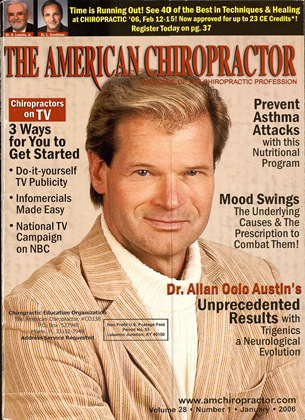Scoliosis Systems™ is a complete chiropractic technique designed to manage idiopathic scoliosis without the use of a rigid brace. Dr. Gary Deut-chman and Dr. Marc Lamantia have combined their thirty years of experience and training in the development of this system, which includes both spinal and vestibular rehabilitation procedures. "The key to the success of spinal remodeling is the use of dynamic movement and neuro-muscular retraining actively performed by the patient," says Dr. Lamantia. The vestibular control of posture has been shown to be abnormal in scoliosis; but the good news is, these imbalances respond well to chiropractic care. Scoliosis Systems™ teaches CE accredited courses co-sponsored by New York Chiropractic College in New York, Los Angeles, and Chicago. There are three modules. Module-1. Spinal Rehabilitation, is taught by Dr. Deutchman and is designed to introduce the concepts of the "Corrective Movement Principle," as well as mobilization and manipulation techniques, to allow soft tissue changes necessary for correction. Module-2, Vestibular Rehabilitation, is taught by Dr. Lamantia, who holds a diplomatc degree in neurology. This course teaches the doctor to identify and correct underlying vestibular deficits associated with scoliosis. "Muscle recruitment patterns are abnormal in scoliosis and contribute to the progressive nature of the disorder. The vestibular system is an avenue for neuro-rehabilitation, and the chiropractor is the most qualified professional to evaluate and balance central nervous system dysfunction," says Dr. Lamantia. Scoliosis Systems™ Module-3 offers a certification in the use of the SpineCor™ brace. SpincCor™ is a flexible dynamic system of elastic straps, which allows for movement into a corrective posture. Drs. Lamantia and Deutchman have trained with some of the top researchers in non-surgical scoliosis treatment, including the developers of the SpineCor and the Rigo Chcrnacu Braces. "The concept of bracing docs not always sit well with chiropractors, but it is an integral part of the non-surgical management of scoliosis. The struggle is to find a brace that is consistent with the chiropractic paradigm of maintaining movement throughout normal growth," says Dr. Gary Deutchman. CASE STUDY This case study follows the treatment of an adolescent female patient with idiopathic scoliosis whose initial presentation was at 9 Vi years of age, and Risser 0 was with a 36° right thoracic curve. Patient C—91/2 years old—36° Path Th 36 LATTh30L56 1814104 After evaluation of the patient's radiological, clinical and postural data, she was classified as a Right Thoracic Type 1 according to the SpineCor classification. Clinical aspect before treatment Radiological aspect before treatment Each SpineCor classification has a specific corrective movement strategy for progressive curve reduction. In the case of Right Thoracic Type I, the corrective movement is counter clockwise rotation of the thorax and clockwise rotation of the shoulder girdle. PATh21 Path Th 16 Scoliosis Systems TM PA Th 4 —| [-LATTh26L38 PAThO PATh2 Patient C's postural correction and Cobb angle reduction have been maintained three years post bracing. SpineCor Brace wearing ceased 3 June 1999, after 15 months of wear. NOTE: All pictures were used with expressed written consent of the SpineCorporation LTD. For more information about seminar dales and locations, visit www.ScoliosisSystems.com, or call Dr. Gary Deutchman at 212-360-7760.
 View Full Issue
View Full Issue









